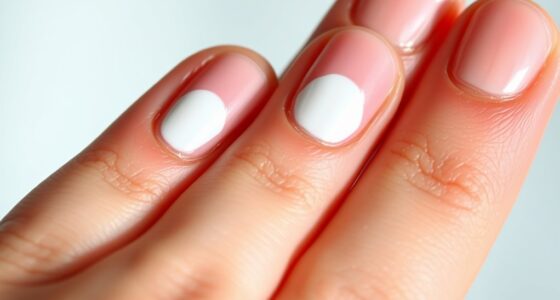The nail matrix is a hidden layer of tissue beneath your cuticle at the nail’s base. It produces new nail cells, driving your nails’ growth and strength. This area is essential for generating keratinocytes that form your nail plate. While resilient, the matrix can be damaged by injuries or health issues, affecting nail appearance. Understanding its role helps you appreciate how your nails continually grow—stay with us to learn more about this fascinating process.
Key Takeaways
- The nail matrix is located beneath the cuticle at the nail’s base, responsible for producing new nail cells.
- It continuously generates keratinocytes that form the nail plate, driving nail growth from early life onward.
- Damage or injury to the matrix can cause deformities, ridges, or nail loss due to disrupted nail production.
- The health of the nail matrix depends on proper nutrition and overall health, ensuring strong and healthy nails.
- Protecting the nail matrix is essential for maintaining steady, strong nail growth and a healthy appearance.

Have you ever wondered what gives your nails their growth and strength? The answer lies in a tiny, yet essential part of your body called the nail matrix. Located beneath your cuticle at the base of your nail, the nail matrix is responsible for producing new nail cells that push outward as they harden. Understanding how this area develops and functions can help you better appreciate how your nails grow and why they sometimes change or become damaged.
The nail matrix beneath your cuticle drives nail growth and strength.
The nail matrix develops early in life and continues its fundamental role throughout your entire lifespan. It’s a dynamic tissue composed of rapidly dividing cells that generate new keratinocytes, the keratin-protein cells that form your nails. As these cells multiply, they push older cells forward, creating the visible nail plate that extends over your fingertip. The process of nail matrix development is continuous, guaranteeing your nails grow steadily over time. Factors like age, health, and nutritional status influence this development, which explains why nails tend to grow slower as you get older or if your body lacks essential nutrients.
The lifespan of the nail matrix is quite remarkable. Despite constant wear and tear, it remains resilient, providing a steady supply of new cells. However, it’s also sensitive to injury and disease. Damage to the nail matrix can result in abnormal nail growth, ridges, or even the complete loss of a nail. For example, trauma to this area might temporarily halt nail production or cause irregularities in the nail’s appearance. In some cases, the nail matrix can recover fully, but in others, prolonged damage might lead to permanent changes. That’s why protecting this tiny tissue is essential if you want healthy, strong nails.
Your nail matrix’s development and lifespan are also intertwined with your overall health. When you’re well-nourished and healthy, your nail matrix functions at its best, producing strong and smooth nails. Conversely, deficiencies in vitamins like biotin or minerals such as zinc can impair its function, leading to brittle or slow-growing nails. Certain medical conditions, like psoriasis or infections, can also affect the nail matrix, causing deformities or pitting. Because the nail matrix is so central to nail growth, any disruption in its development or lifespan can profoundly impact the appearance and health of your nails.
In essence, the nail matrix is the powerhouse behind your nail growth. Its development from early life onward and its ability to sustain nail production throughout your lifespan highlight its importance. Taking care of this small but mighty part of your body by maintaining good health and avoiding injury can help guarantee your nails stay strong, smooth, and healthy for years to come.
Frequently Asked Questions
Can Nail Matrix Damage Be Permanently Repaired?
If your nail matrix is damaged, it might not fully recover, leading to permanent changes like abnormal nail growth. Nail regeneration depends on the extent of damage; minor injuries can heal with minimal scarring, but serious damage may result in matrix scar tissue that impairs growth. While some treatments can improve appearance, complete repair of severe damage isn’t always possible, so understanding your specific situation helps determine potential outcomes.
How Does Age Affect Nail Matrix Health?
Imagine your nail matrix as a vibrant garden that gradually withers with age. As you grow older, age-related changes can slow down cell production, leading to thinner, weaker nails. These changes affect nail health, making nails more prone to splitting and ridges. While your matrix can still produce nails, aging can diminish its efficiency, emphasizing the importance of proper care to maintain your nail’s strength and appearance over time.
Are There Signs Indicating Nail Matrix Infections?
If you notice changes like redness, swelling, pain, or pus around your nails, you might have a nail infection. Matrix symptoms often include ridges, discoloration, or abnormal nail growth. These signs indicate your nail matrix could be infected or inflamed. Don’t ignore persistent issues—seek medical advice promptly to prevent further damage and guarantee proper treatment. Recognizing these symptoms early helps protect your nail health effectively.
Does Nail Polish Harm the Nail Matrix?
Nail polish might seem harmless, yet it can secretly affect your nail matrix health. While it adds beauty, frequent use or harsh formulas can trap moisture and chemicals, risking damage to the nail matrix. Think of it as beauty’s double-edged sword—enhancing appearance but potentially harming the foundation of your nails. To protect your nail matrix, choose gentle polishes, give your nails regular breaks, and prioritize overall nail health over fleeting trends.
Can Nail Matrix Issues Cause Permanent Nail Deformities?
Yes, nail matrix issues can cause permanent nail deformities. Damage to the matrix, where your nail growth begins, can disrupt proper nail formation. If the matrix sustains significant damage, it may lead to abnormal nail growth or permanent deformities. To prevent this, you should avoid trauma and harsh chemicals near the nail base. Recognizing early signs of matrix damage is essential for maintaining healthy nail growth and preventing lasting deformities.
Conclusion
Understanding your nail matrix reveals that healthy nails depend on proper care of this hidden area. Some believe nail growth is solely genetic, but environmental factors and nutrition play a vital role. It’s a common misconception that applying harsh chemicals doesn’t affect your nails—yet, they can damage the matrix over time. Taking care of your nails by avoiding trauma and nourishing your body supports a strong, healthy nail matrix, proving that your habits truly influence your nail health more than you might think.









